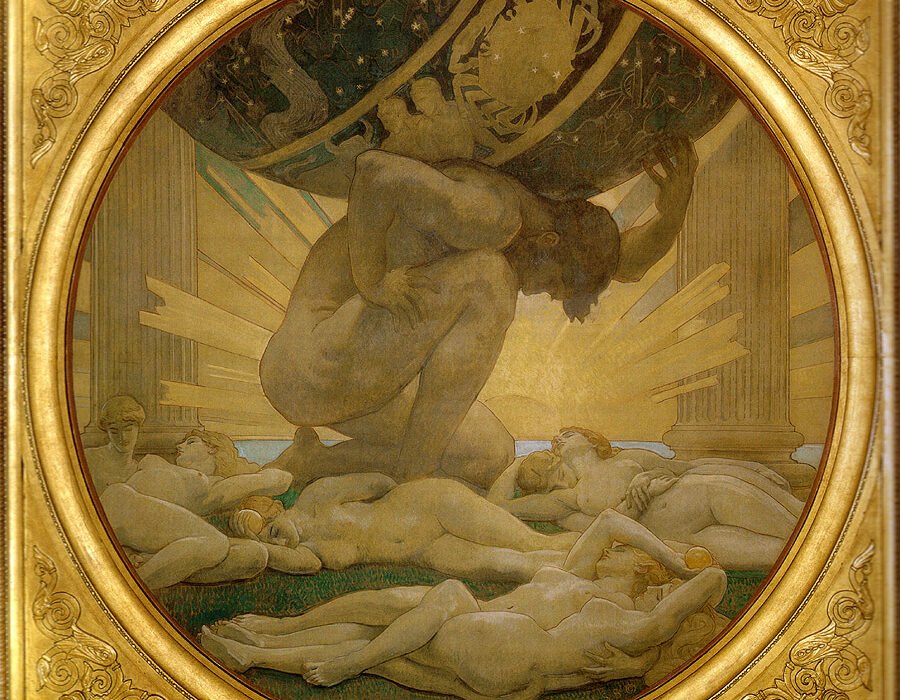Among the vast tapestry of Greek mythology, woven with gods, monsters, and mortal heroes, there exist figures both feared and misunderstood. The Harpies—creatures of the sky, half-woman and half-bird—emerge from ancient stories like shrieking winds in the midst of a storm. To the Greeks, these beings were not simply monsters but embodiments of nature’s fury, messengers of divine wrath, and omens of punishment. Their name, derived from the Greek word harpazō, meaning “to snatch” or “to seize,” perfectly encapsulates their role: relentless spirits of sudden storms that seize both men and their destinies.
The Harpies are at once terrifying and fascinating. They embody the unpredictability of the natural world, a reminder of how easily life could be disrupted by forces beyond human control. In the myths, they swoop down to steal food, abduct souls, or torment mortals, yet they are also part of a deeper symbolic language—spirits that carry away what must be taken, whether sustenance, sanity, or life itself.
To tell the story of the Harpies is to journey through myth, symbolism, and ancient belief. These winged spirits of storms are more than grotesque monsters. They are echoes of a time when every gust of wind, every flash of lightning, and every sudden misfortune was thought to be guided by divine or demonic hands.
The Origins of the Harpies in Greek Mythology
The Harpies first appear in the ancient Greek imagination during the earliest layers of myth. Hesiod, in his Theogony, mentions them as daughters of Thaumas (a sea deity) and Electra (an Oceanid). This parentage situates them within a cosmic family: beings born of the marriage between wonder (Thaumas) and the sea’s vast depths (Electra). Their sisters are the rainbow goddess Iris, who serves as the messenger of the gods, and thus the Harpies, too, inherit a role as intermediaries between divine will and mortal lives.
Initially, only two Harpies were named—Aello (Storm-swift) and Ocypete (Swift-wing). Later sources add Celaeno (the Dark one), further intensifying their fearsome image. The names themselves are deeply telling. Aello, the storm, is the sudden rush of wind that whirls and destroys. Ocypete is the embodiment of speed, the unstoppable force of storm clouds moving across the heavens. Celaeno represents darkness and doom, the black thundercloud that blots out the sun.
Thus, in their very names, the Harpies reveal their true essence: they are not merely creatures but personifications of the storm itself.
Half-Woman, Half-Bird: Their Terrifying Appearance
Ancient writers struggled to fully capture the appearance of the Harpies. They were depicted as winged women with sharp talons, fierce eyes, and hair that whipped in the wind. In early depictions, they were not always monstrous but rather swift maidens of the air. Over time, however, their imagery darkened. They became haggard and ravenous, with claws for hands, wings that blotted out the sky, and a stench that followed wherever they flew.
The Harpies were terrifying not only for their appearance but for what they represented. In a world where storms could wreck ships and ruin harvests, where sudden winds could spell death at sea or in the mountains, the Harpies embodied this raw, uncontrollable chaos. Their monstrous features symbolized the ugliness of destruction, while their feminine aspects hinted at the deceptive beauty of storms: dazzling in their lightning, yet deadly in their power.
In art and pottery, they are sometimes shown swooping down upon mortals, clutching them in talons or spiriting them away. Their imagery resonated so strongly with fear that even the later Romans adopted the Harpies into their mythology, imagining them as agents of punishment in the underworld.
The Harpies and the Tale of Phineus
The most famous story involving the Harpies is the legend of King Phineus of Thrace, a prophet cursed by the gods. Phineus had been granted the gift of foresight, but when he revealed too much of the gods’ secrets to humankind, he incurred their wrath. His punishment was cruel: every time he sat down to eat, the Harpies would swoop down from the skies, snatching his food away or defiling it with their foul touch.
Phineus was left in perpetual hunger, tormented by the shrieking wings of the Harpies. His suffering continued until the arrival of the Argonauts, the band of heroes led by Jason in search of the Golden Fleece. Among them were the Boreads, Calais and Zetes, sons of the North Wind. With wings upon their feet, they alone could chase the Harpies through the air.
The pursuit of the Harpies was a dramatic clash between forces of wind: the Boreads, embodiments of the cold north gusts, against the storm-spirits themselves. At the brink of their capture, the goddess Iris intervened. She promised that the Harpies would trouble Phineus no longer, and so they retreated, spared from destruction but forever remembered as agents of divine punishment.
This myth captures the essence of the Harpies’ role in Greek thought. They are not evil for evil’s sake, but tools of cosmic justice, enforcing the will of the gods in terrifying ways.
Harpies as Agents of Punishment and Justice
In later mythology and Roman adaptations, the Harpies took on a darker role. They were often described as agents of punishment in the underworld, snatching away the souls of the wicked and carrying them to torment. In Virgil’s Aeneid, they appear to torment Aeneas and his men, stealing their food and prophesying their struggles.
This evolution reflects a broader shift in how the ancients perceived them. As Greek mythology merged with Roman beliefs, the Harpies became less tied to natural storms and more associated with moral retribution. They were seen as furies of the sky, punishers of hubris, and reminders that no one could escape divine justice.
The Harpies embody the fear of being taken suddenly—whether by storm, fate, or death itself. Their ability to seize mortals without warning echoes the unpredictability of life. In this way, they are not merely villains of myth but symbols of cosmic inevitability.
The Harpies in Symbolism and Ancient Belief
To the Greeks, every myth was also a metaphor. The Harpies were no exception. Their role as snatchers resonated on many levels—natural, psychological, and spiritual.
On one level, they were literal personifications of storm winds. Seafarers and farmers alike feared sudden gales that could sweep away crops or capsize ships. To imagine these winds as winged creatures gave shape to an otherwise invisible terror.
On another level, they symbolized the sudden theft of joy, peace, or life. Just as they robbed Phineus of his meals, so too could fate rob mortals of their happiness. They embodied loss itself—the cruel reminder that nothing in life is guaranteed.
Finally, they carried spiritual symbolism. As agents of the gods, the Harpies represented the inescapability of divine justice. They were fate’s enforcers, ensuring that punishment found its mark.
Thus, the Harpies moved fluidly between natural phenomenon and moral allegory. They were winds, but they were also warnings.
Harpies in Literature and Art
The Harpies left a lasting mark on art and literature. Greek pottery often depicted them with wings spread wide, carrying off men or swooping down upon helpless mortals. Their image was a popular motif in both funerary and religious contexts, perhaps as a reminder of life’s fragility.
In literature, they appear in works ranging from Hesiod to Apollonius of Rhodes to Virgil. Each retelling reshaped their character: sometimes monstrous, sometimes divine, always awe-inspiring. Later poets and writers of the Renaissance and Romantic eras reimagined the Harpies as metaphors for greed, destruction, or fate.
Perhaps one of the most chilling depictions comes from Dante Alighieri’s Inferno, where Harpies inhabit the Wood of the Suicides, tormenting the souls of those who took their own lives. Here, their birdlike, grotesque forms embody anguish and torment, cementing their legacy as symbols of punishment.
The Harpies in Modern Culture
Though born from ancient myth, the Harpies continue to haunt modern imagination. They appear in fantasy novels, films, and games, often reimagined as monstrous bird-women or storm-witches. In popular culture, they are frequently cast as antagonists, their shrieking cries and clawed hands making them perfect villains.
Yet even in modern retellings, echoes of their original symbolism remain. They are still linked to storms, destruction, and the inevitability of fate. They still embody the fear of being seized without warning. And they still captivate us with their eerie blend of beauty and terror.
The Harpies remind us that mythology never truly dies. It transforms, finding new wings in every age.
The Psychological and Archetypal Meaning of Harpies
Beyond myth and art, the Harpies also resonate on a psychological level. In Jungian terms, they can be seen as archetypes of the devouring mother or the destructive feminine, forces that drain vitality and rob life of joy. In this sense, they symbolize inner struggles: the fears, anxieties, and destructive thoughts that swoop down upon the mind.
Yet, just as in mythology they were not purely evil but instruments of divine order, so too can they symbolize necessary forces in life. The Harpies snatch away what is not meant to be kept—whether that be pride, forbidden knowledge, or even outdated ways of being. They remind us that loss, however painful, is often part of growth.
Thus, the Harpies are not only mythological figures but psychological mirrors. They reveal the storms within us as much as the storms without.
Harpies as Symbols of Nature’s Duality
Ultimately, the Harpies are emblematic of one of mythology’s central truths: nature is both beautiful and terrifying. The same winds that carry ships to distant lands can also shatter them against rocks. The same storms that water the earth can also destroy harvests.
The Harpies embody this duality. They are swift, majestic, and awe-inspiring, yet they are also cruel and merciless. They are the breath of the gods, but also their scourge. They are not evil for its own sake but necessary forces in the great balance of the cosmos.
In them, we see the storm not just as destruction but as transformation. The winds that strip away can also clear paths for renewal. The Harpies, in all their terrifying splendor, remind us that life itself is a balance between creation and loss.
The Enduring Legacy of the Harpies
Across centuries, the Harpies have continued to fly through human imagination, carried on the winds of myth, art, and psychology. They are more than monstrous bird-women from an ancient tale. They are enduring symbols of nature’s fury, fate’s inevitability, and the suddenness of loss.
The Harpies teach us that to live is to accept unpredictability, to understand that joy and sorrow can be snatched away in an instant. Yet in their shrieks and storms, there is also wisdom. They remind us that life is precious precisely because it is fragile, that every calm sky holds the potential for storms.
From the windswept cliffs of ancient Greece to the pages of modern fantasy, the Harpies endure. They are shadows with wings, storm-spirits who snatch and seize, eternal reminders of the tempestuous beauty of existence.






